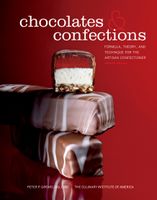Advertisement
General Guidelines
Appears in
By Peter Greweling and Culinary Institute of America
Published 2007
While detailed knowledge of chocolate manufacturing is not essential for confectionery success, knowing how to handle and store chocolate is. The basic guidelines for handling chocolate are rather simple: always keep chocolate away from moisture and excessive heat; these are the two factors that destroy chocolate more rapidly than all others. Also, chocolate should be stored in a cool, dark place, away from strong odors that can taint its flavor.
A very small amount of moisture in chocolate noticeably increases its viscosity, making it unacceptable for dipping or enrobing. When melting chocolate, be careful not to allow excess steam to develop, which will interface with the surface of the chocolate, moistening it and increasing the viscosity. When working with chocolate, always be certain that all utensils and surfaces are dry. Chocolate that has been exposed to moisture may still be used in some applications, such as chocolate caramels or chocolate fudge, but it should not be used for dipping or enrobing.



